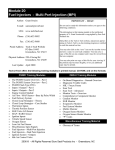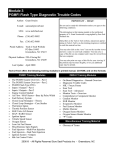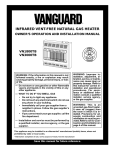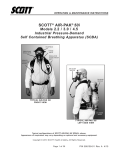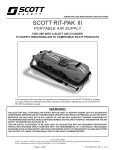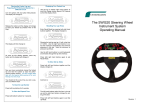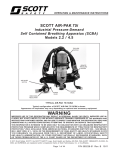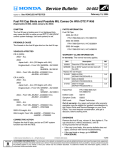Download Module 33 Evaporative Monitor
Transcript
Module 33 Evaporative Monitor Author: Grant Swaim E-mail: [email protected] URL: www.tech2tech.net Phone: (336) 632-9882 Fax: (336) 632-9688 IMPORTANT - READ ! Do not read or study this information unless you agree to the following conditions: The information in this training module is the intellectual property of Grant Swaim and is copyrighted by Sure Seal Products Inc. As a subscriber to the Tech-2-Tech website, or the on-line training Postal Address: Tech-2-Tech Website PO Box 18443 Greensboro, NC 27419 Physical Address: 220-4 Swing Rd Greensboro, NC 27409 Last Update: October 2000 Tech-2-Tech offers the following training modules in printed manual, CD-ROM, and on-line formats. PGMFI Training Modules • • • • • • • • • • • • • • • • • • • • • • • The PGMFI System Overview—Part 1 The PGMFI System Overview—Part 2 PGMFI Flash Type DTCs Inputs / Outputs—Part 1 Inputs / Outputs—Part 2 Engine Control Module Air Flow / MAP Sensor—Base Inj Pulse Width Fuel Delivery System Closed Loop Strategies—Theory Closed Loop Strategies—Case Studies Thermistor Inputs Throttle Position Sensor EGR Valve Lift Sensor MAP / BARO Sensor Ignition Inputs Vehicle Speed Sensor Oxygen Sensor Lean Air Fuel Sensor Miscellaneous Input Signals Fuel Injectors—Multi-Port Injection Fuel Injectors—Dual Point Injection Ignition System—Outputs Idle Air Control Valve OBD-II Training Modules • • • • • • • • • • • • • • • On Board Diagnostics—General Overview Diagnostic Trouble Codes MIL / Freeze Frame Scan Tool Scan Tool—Advanced Monitor Tests—Overview Comprehensive Component Monitor Catalyst Monitor EGR Monitor Evaporative Monitor Fuel System Monitor Misfire Monitor Oxygen Sensor Monitor Oxygen Sensor Heater Monitor “P” Codes Miscellaneous Training Material • Glossary of Terms 2000 © - All Rights Reserved Sure Seal Products Inc - Greensboro, NC Visit Our Website: www.tech2tech.net Page 33-1 33 Evaporative Monitor Run: Once-Per-Trip Enable Criteria: 1. Using an OBD-II compatible scan tool monitor the ECT and IAT parameters. 2. The car must be started with an ECT and IAT sensor reading of at least 32o F, but not over 95o F. 3. The ECT and IAT sensors must be within 5o F of each other. 4. Fuel tank must not be over 85% full or below 15% full. 5. Monitor the bypass valve* for activation, to be assured the EVAP monitor has begun to run, by either: a. Watching for the sensor’s ground activation b. Watching for the sensor’s “ON” status with a Mastertech scan tool equipped with the Honda software. 6. Start the car 7. If the bypass is activated at start-up, go to step 10. If the bypass valve is not activated** within 3 seconds, cut the car off. 8. Restart the car. 9. If the bypass valve is not activated** within 3 seconds cut the car off. The monitor is not going to run under the current conditions. 10. Test drive the car as close to a steady road speed as possible. 11. The EVAP monitor should run within approximately 5 miles. * You can find more information about the location and operation of the bypass valve in Section 33.1.3. ** In most cases the bypass valve will activate on and stay on for a long period. In some cases the bypass valve is only activated for approximately 3 seconds. Either one of these situations is an indication that the EVAP monitor is running. DTC A diagnostic trouble codes (DTC) generated from this monitor is stored on the second malfunction (first malfunction on a purge flow switch) during a consecutive running of the monitor. All DTCs set from this monitor are standard priority within the freeze frame writing strategy. A freeze frame written by one of these DTCs can only be over written by a high priority DTC, not another standard priority DTC. MIL Info Illumination © Sure Seal Products, Greensboro, NC – All Rights Reserved Page 33-2 Visit Our Website: www.tech2tech.net The malfunction indicator light (MIL) is illuminated when a second (first on purge flow switch malfunction) DTC is stored. Extinguishing The MIL is extinguished after three trips without a malfunction reoccurring. General Info: Hondas are equipped with an evaporative system that stores fuel vapors during parked periods and burns those vapors during running periods. Some of the newer models also have an on-board refueling vapor recovery (ORVR) system to capture fuel vapors during refueling. The evaporative systems fall into two different types, standard and enhanced. Both systems are checked for proper purge flow through the EVAP canister. Only the enhanced systems are checked for leaks by the EVAP monitor. Only a few 1996 models were equipped with the enhanced systems. By 1998, all models were equipped with the enhanced system. As on most OBD-II equipped vehicles, the Honda evaporative system is somewhat complex. For example, in the 1998 Accord service manual, the evaporative diagnostic and repair procedures include over 85 steps and 30 illustrations. The remainder of this chapter is devoted to a diagnostic procedure for testing the evaporative system for leaks. This procedure is very effective and much easier to follow than most procedures covered in service manuals. DTCs Generated by the EVAP Monitor OBD MIL Trips Code Flash Description P0441 92 2 EVAP – Insufficient Purge Flow P1456 90 2 EVAP – Leak Detected (Fuel Tank System) P1457 90 2 EVAP – Leak Detected (Control Canister System) P1459 92 1 EVAP – Purge Flow Switch Malfunction © Sure Seal Products, Greensboro, NC – All Rights Reserved Visit Our Website: www.tech2tech.net Page 33-3 33.1 Evaporative System – General Overview Honda uses two different evaporative systems; the standard system that checks for canister purge flow only and the enhanced systems that add leak detection. Enhanced systems are found on a few 1996 models, and were added to all systems by 1998. This training module concentrates on the enhanced systems. The enhanced systems are composed of these main components: This solenoid type valve is duty cycled by the ECM to obA Purge Control Valve tain proper canister purge The valve is normally open and is only commanded shut B Canister Vent Shut (CVS) by the ECM when it is leak checking the evaporative sysValve tem The canister stores the gas tank emissions during parked C Canister periods. The canister is purged during driving periods D Two-Way Valve This mechanical valve allows the gas tank to vent when the pressure exceeds approx .6 inHg, either positive or negative. During a leak check the ECM activates the bypass valve, E Bypass Valve which bypasses the two-way valve. F Fuel Tank Pres- A 5v reference type sensor that produces a voltage proporsure (FTP) Sen- tional to tank pressure. A tank with no pressure produces a sor FTP sensor voltage of 2.45-2.55v. The gas tank filler cap for an enhanced evaporative system G Gas Tank With Special Filler is specially designed. Cap © Sure Seal Products, Greensboro, NC – All Rights Reserved Page 33-4 Visit Our Website: www.tech2tech.net 33.1.1 Purge Control Valve Image 33-1 Purge Control Valve on a 2000 CRV The purge control valve is a duty cycled solenoid type valve. The valve is normally closed. The valve is fed battery voltage directly and the ECM controls the ground. You may manually activate this valve by providing a ground to the valve (at the valve or the ECM) while the key is “On”. The ECM controls the amount of air that purges the evaporative canister by duty cycling this valve, which applies manifold vacuum to the evaporative system. The duty cycle of the purge control valve varies widely based on many engine conditions. The canister is typically not purged at idle and is purged more at higher speeds. The valve’s duty cycle can be measured directly with a digital storage oscilloscope (DSO) or with a Mastertech scan tool equipped with Honda software. The purge control valve is usually mounted on the intake manifold, the left shock tower, or the firewall. One way to identify the purge control valve is to follow the hose from the canister back towards the engine. 33.1.2 Canister / Canister Vent Shut (CVS) Valve Image 33-2 Canister on a 2000 Accord As you follow the hose from the purge control valve towards the tank, the next component you will find is the canister. The canister is either located under the car (usually in front of the gas tank) or under the hood (on the firewall). Image 33-2 is the canister on a 2000 Accord and it is located under the car. If the evaporative system is an enhanced version the canister will have a canister vent shut © Sure Seal Products, Greensboro, NC – All Rights Reserved Visit Our Website: www.tech2tech.net Page 33-5 (CVS) valve mounted on it. The CVS valve is an electrically activated solenoid type valve that is either on (valve closed) or off (vent open). The valve is normally open and is only closed by the ECM to run the EVAP leak check. The valve is fed battery voltage directly and the ECM controls the ground. You may manually activate this valve (make it close) by providing a ground to the valve (at the valve or the ECM) while the key is “On”. 33.1.3 Two-Way Valve / By-Pass Valve Image 33-3 Two-Way and By-Pass Valve As you leave the canister headed towards the gas tank the next component you find is the twoway valve / by-pass valve. All Honda evaporative systems have a two-way valve, but only the enhanced systems have the bypass valve. The two-way valve is usually located under the car and close to the gas tank. A few models have the two-way valve located under the hood. The left ward pointing arrow in Image 33-3 shows the valve’s location on a 2000 CR-V. The two-way valve is a mechanical pressure controlling valve. When the gas cap is installed all the tank venting, both positive and negative, is controlled by the two-way valve. When the tank pressure builds up to approximately .6 inHg (either positive or negative) the two-way valve opens and allows the pressure to either vent the fumes to the canister or draw air into the tank. The by-pass valve is an electrically actuated solenoid type valve that is normally closed. The valve is attached to the two-way valve and is designed to allow the two-way valve to be by-passed when it is actuated. The by-pass valve is indicated by the down ward pointing arrow in Image 33-3. The two-way valve is only bypassed during the EVAP monitor leak checks. The valve is fed battery voltage directly and the ECM controls the ground. You may manually activate this valve (make it open and bypass the two-way valve) by providing a ground to the valve (at the valve or the ECM) while the key is “On”. © Sure Seal Products, Greensboro, NC – All Rights Reserved Page 33-6 Visit Our Website: www.tech2tech.net 33.1.4 Fuel Tank Pressure (FTP) Sensor All enhanced systems are also equipped with a fuel tank pressure (FTP) sensor. The sensor is a 5v reference type sensor that produces a voltage that is proportional to the gas tank’s pressure. The FTP sensor is connected to the two-way valve by a short hose. The FTP sensor is indicated by an up ward pointing arrow in Image 33-3. When the tank is not pressured (is open to the atmosphere) the FTP reading should be between 2.45-2.55v. You may read this with a digital volt ohm meter (DVOM) or with a Mastertech scan tool equipped with Honda software. 33.1.5 Enhanced System Gas Cap Image 33-4 Enhanced System Cap The gas cap is also different on an enhanced system. The gas cap on an enhanced system should contains the words: “If not tightened 3 clicks check engine light may come on” Image 33-4 shows the proper gas cap for the enhanced systems. Loose or improper gas caps are the number one cause of EVAP monitor failures. 33.2 Preliminary Testing Honda’s enhanced evaporative system is tested for both proper canister purge and for leaks. The EVAP monitor can also narrow a leak down to the tank part of the system or the canister part of the system. When a tank area leak is detected on two consecutive EVAP monitor tests a P1456 DTC is stored. When a canister area leak is detected on two consecutive EVAP monitor tests a P1457 DTC is stored. The test procedures covered in this manual will concentrate on these two failures. Section 33.2 will concentrate on preliminary tests that should be performed before any specific leak checks are performed. Sections 33.3 & 33.4 will concentrate on the tank area leaks, which store a P1456 DTC. Section 33.5 & 33.6 will concentrate on the canister area leaks, which store a P1457 DTC. © Sure Seal Products, Greensboro, NC – All Rights Reserved Visit Our Website: www.tech2tech.net Page 33-7 33.2.1 Visual Inspection When checking a Honda that has stored a DTC indicating an evaporative system leak, begin by performing a visual on the entire system. Look for loose hose connections, unplugged electrical connectors, or for any wreck damage to the evaporative system components. Keep in mind that evaporative components start at the intake manifold and end up at the gas tank. Some systems have the canister under the hood and some have the canister under the car. The two-way and bypass valves are usually located under the car, also. You will need to put the car on a lift to do a thorough visual inspection of the evaporative system. If diagnosing an evaporative leak after any significant body damage, be sure to check all the components for cracks. Most of the components are plastic and can be easily damaged. Also the steel lines, located underneath the car, that run from the front of the car to the rear of the car should be closely inspected after any body damage, 33.2.2 Gas Cap One of the biggest causes of evaporative leak check failures is an incorrect gas cap or loose gas cap. Confirm that the gas cap is in fact the correct one for an enhanced evaporative system. Refer to Section 33.1.5 for more information about the enhanced system gas cap. If the gas cap is the correct part, you will need to confirm that it is tight. Before you twist on the gas cap, you might want to do a quick preliminary check to see if the cap was loose when it came in. You can do this by determining if the tank is leaking before you check the tightness of the cap, then see if the leak stops after you tighten and/or replace the cap. Screen Capture 33-1 To do a quick check for a leaking gas cap start by checking the fuel tank pressure (FTP) sensor voltage. This can be done with a DVOM or a Mastertech scan tool equipped with Honda software. Screen Capture 33-1 is from a Mastertech. For more information about reading the FTP sensor voltage see Section 33.2.3. When there is no pressure on the tank, the FTP sensor voltage should read between 2.45-2.55v. As tank pressure rises, the voltage will rise above this level. As the tank pressure decreases, the voltage will drop below this level. © Sure Seal Products, Greensboro, NC – All Rights Reserved Page 33-8 Visit Our Website: www.tech2tech.net With the ever changing temperature of the fuel in the gas tank, it is rare that the FTP sensor reads 2.5v. For instance, if a car has sat outside and has cooled overnight, it is normal for the FTP sensor voltage to be under 2.5v. If a car is sitting outside during the day where the temperature has risen significantly it is normal to see a FTP sensor reading over 2.5v. Due to the fuel being constantly pumped to the fuel rail and returned to the tank (except for return less systems on some 2001 models), the fuel in the tank will usually rise at least 300F on a running Honda. This means that a running Honda will almost always have a rising FTP sensor voltage. If the ambient temperature is extremely cold or falling, this may not be the case. With this in mind, before disturbing the gas cap, check the FTP sensor voltage. If the reading is 2.5v, yet conditions exist that would normally created a high or low tank pressure, then there probably is a leak. Then tighten the cap to see if the tank pressure changes over the next 15-20 minutes. If it does the gas cap was not tight enough. If tightening the cap did not make a difference, try a known good gap and see if the tanks pressure changes. If so the original cap is bad. The best way to create a situation where the fuel tank pressure should be changing is to heat up the fuel in the tank, by running the engine, which will cause a pressure rise. A Honda running, at least 20 minutes, should have a rising FTP sensor voltage. On a hot day the FTP sensor voltage will quickly reach the maximum of about 3.1v. The two-way valve will bleed off any pressure above this. 33.2.3 Check FTP sensor Image 33-5 Since almost all evaporative leak checks revolve around the FTP sensor output, you need to start by checking it first. The FTP sensor has three wires, and is a 5-volt reference type sensor. The ECM supplies a reference voltage (5v) and a ground to the sensor over two of the wires. The FTP sensor returns back an analog voltage to the ECM over the third wire. While this is a listed parameter on a Mastertech scan tool equipped with Honda soft ware, you can also get this voltage using a standard DVOM. Image 33-5 shows the FTP sensor on a 2000 CRV. Note the 3-wire connector. If checking the FPT sensor voltage using a DVOM, simply back probe this connector until you find the input wire. Remember one wire should have approx 5v on it, © Sure Seal Products, Greensboro, NC – All Rights Reserved Visit Our Website: www.tech2tech.net Page 33-9 one should have a ground (less than 50mv) on it and one will have the input voltage of approx 2.5v. Fuel Tank Pressure Sensor Test 1. Remove the gas cap 2. Make sure the tank is not completely full, drain out gas as needed. 3. With key on engine off (KOEO) Check the FTP sensor voltage. It should be between 2.45-2.55v and steady. If so the sensor is good. If not go to step 4. 4. Disconnect the hose between the FTP sensor and the two-way valve. 5. With KOEO, recheck the FTP sensor voltage. It should be between 2.452.55v and steady. If so the sensor is good, however there is a restriction in the evaporative system, go to step 5. If not replace the FTP sensor and retest. 6. Look for a restriction between the FTP and the gas tank. This is usually caused by a defective onboard refueling vapor recycling (ORVR) system, which allows gasoline to enter the evaporative system. If gas is present, replace all components exposed to the gas, replace the ORVR valve, and re-test the FTP sensor. 33.2.4 Solenoid Check The last step in the preliminary checks is to confirm that each of the three electrically activated valves (purge control, canister vent shut, and bypass) do respond to activation. You should activate each valve and confirm that the valve “clicks” whole holding it. Replace any defective valves and retest the system. The easiest way to activate these valves is to use the bi-directional commands from a Mastertech scan tool using the Honda Software Version SN010, or later. If you do not have the capability to activate these valves with a scan tool, you can always activate each one individually by providing a ground to the valve. All the valves are fed battery voltage and the ECM provides the ground. You can manually activate each valve by providing a ground at each of the valves. You will need to first identify the power and ground wire on the sensor using a test light or DVOM. © Sure Seal Products, Greensboro, NC – All Rights Reserved Page 33-10 Visit Our Website: www.tech2tech.net Following is the menu sequence to follow to activate the solenoids with a Mastertech scan tool using Honda software Version SN010 or later. Screen Capture 33-2 This is the main menu of a Mastertech scan tool using the Honda software Version SN010 or later. From this menu choose: 6: INSPECTION Screen Capture 33-3 From the Inspection Menu choose: 2. EVAP TEST Screen Capture 33-4 From the Evap Test Menu choose: 1: SINGLE SOLENOID To activate the valves one at a time 2: MULTI SOLENOIDS To activate more than one valve at a time Screen Capture 33-5 From the Single Solenoid Menu you can activate and deactivate each of the three evaporative valves. © Sure Seal Products, Greensboro, NC – All Rights Reserved Visit Our Website: www.tech2tech.net Page 33-11 Screen Capture 33-6 From the Multi Solenoids Menu you can activate more than one of the evaporative valves in different combinations. © Sure Seal Products, Greensboro, NC – All Rights Reserved Page 33-12 Visit Our Website: www.tech2tech.net 33.3 P1456 Test Procedure – For Under Hood Canister Models Use this diagnostic procedure if you have a stored P1456 DTC. This is an indication that you have a leak in the tank area of the system. This procedure is for models with the canister mounted under the hood. For models with the canister mounted under the car see Section 33.4. 1. 2. 3. 4 5. 6. The gas tank should be at least ½ full but not completely full. Make sure the proper cap is in place and tight Activate the Bypass Valve Disconnect the hose between the two-way valve and canister at the canister. This hose is usually labeled “Tank” on the canister. Connect a vacuum pump to the hose. See Section 33.2.4 Image 33-6 Apply vacuum until the FTP sensor reads 1.49v. As soon as the voltage rises to 1.5v start timing a 20 second period. If the voltage rises above 1.55v in 20 seconds the leak check has failed If the system passed the leak check there is no problem. If it failed the leak check, go to step 7. © Sure Seal Products, Greensboro, NC – All Rights Reserved Visit Our Website: www.tech2tech.net 7. Leave the vacuum pump attached, but pinch off the hose between the two-way valve and the gas tank. Page 33-13 Image 33-7 Note that on most models the two-way valve is under the car and close to the gas tank, such as shown in Image 33-7. On a few models this valve is located under the hood. 8. 9. Re-run the leak check described in Step 5. If the system passes the test, there is a leak in the tank area. If the system fails the test there is a leak in the twoway/bypass valve area 10. Diagnose leak, repair, and retest the system. © Sure Seal Products, Greensboro, NC – All Rights Reserved Page 33-14 Visit Our Website: www.tech2tech.net 33.4 P1456 Test Procedure – For Under Car Canister Models Use this diagnostic procedure if you have a stored P1456 DTC. This is an indication that you have a leak in the tank area of the system. This procedure is for models with the canister mounted under the car. For models with the canister mounted under the hood, see Section 33.3. 1. 2. 3. 4 5. 6. The gas tank should be at least ½ full but not completely full. Make sure the proper cap is in place and tight Activate the Bypass Valve Disconnect the hose between the two-way valve and canister at the canister. This hose is usually labeled “Tank” on the canister. Connect a vacuum pump to the hose. See Section 33.2.4 Image 33-8 Apply vacuum until the FTP sensor reads 1.49v. As soon as the voltage rises to 1.5v start timing a 20 second period. If the voltage rises above 1.55v in 20 seconds the leak check has failed If the system passed the leak check there is no problem. If it failed the leak check, go to step 7. © Sure Seal Products, Greensboro, NC – All Rights Reserved Visit Our Website: www.tech2tech.net 7. If the car is equipped with an ORVR system follow this step, if not skip to step 10. Page 33-15 Image 33-9 If the car is equipped with the ORVR system it will have an third hose attached to the canister. The hose is large in size and is attached to the canister with a “quick disconnect” type fitting. 8. 9. Disconnect the ORVR hose from the canister and plug the hose Re-run the leak check described in Step 5. If the system passes the test, replace the ORVR valve. If the system fails the test, reconnect the ORVR hose and proceed to step 10. 10. Leave the vacuum pump attached, but pinch off the hose between the two-way valve and the gas tank. Image 33-10 11. Re-run the leak check described in Step 5. © Sure Seal Products, Greensboro, NC – All Rights Reserved Page 33-16 Visit Our Website: www.tech2tech.net 12. If the system passes the test, there is a leak in the tank area. If the system fails the test there is a leak in the twoway/bypass valve area 13. Diagnose leak, repair, and retest the system. © Sure Seal Products, Greensboro, NC – All Rights Reserved Visit Our Website: www.tech2tech.net Page 33-17 33.5 P1457 Test Procedure – For Under Hood Canister Models 1. Isolate the fuel tank from the system by clamping off the hose that goes from the two-way valve to the fuel tank. Image 33-11 Note that on most models the two-way valve is under the car and close to the gas tank, such as shown in Image 33-11. On a few models this valve is located under the hood. 2. 3. 4. Activate the purge control valve, canister vent shut valve, and bypass valve either manually or by using the Mastertech scan tool. See Section 33.2.4 Image 33-12 Disconnect the hose between the intake manifold and the purge control valve at the manifold. Attach a vacuum pump to this hose. Apply vacuum until the FTP sensor reads 1.49v. Then disconnect the purge control valve and vent the vacuum pump. © Sure Seal Products, Greensboro, NC – All Rights Reserved Page 5. 6. 7. 8. 9. 33-18 Visit Our Website: www.tech2tech.net As soon as the voltage rises to 1.5v start timing a 20 second period. If the voltage rises above 1.55v in 20 seconds the leak check has failed If the system passes this leak check there is no problem. If the system failed this leak test go to step 7. Disconnect the hose from the purge control valve to the canister from the purge control valve. Attach a vacuum pump to this hose. Image 33-13 Apply vacuum until the FTP sensor reads 1.49v. As soon as the voltage rises to 1.5v start timing a 20 second period. If the voltage rises above 1.55v in 20 seconds the leak check has failed. If the system passes this leak check, the purge control valve is leaking, replace the valve and retest. If the system fails the test, go to step 10. © Sure Seal Products, Greensboro, NC – All Rights Reserved Visit Our Website: www.tech2tech.net 10. With the vacuum pump still attached pinch off the canister vent shut valve hose Page 33-19 Image 33-14 11. Re-test for a leak using the test from step 8. 12. If the system passes this leak check, the canister vent shut valve is leaking, replace the valve and retest. If the system fails the test, go to step 13. Image 33-15 13. Disconnect the hose from the canister and two-way valve at the canister; this is often labeled at the canister as “Tank”. Attach a vacuum pump to this hose. © Sure Seal Products, Greensboro, NC – All Rights Reserved Page 33-20 Visit Our Website: www.tech2tech.net 14. Re-test for a leak using the test from step 8. 15. If the system passes this leak check, the canister is leaking, replace the canister and retest the system. If the system fails the test, there is a leak in the twoway valve / bypass valve area. Diagnose, repair and retest the system. © Sure Seal Products, Greensboro, NC – All Rights Reserved Visit Our Website: www.tech2tech.net Page 33-21 33.6 P1457 Test Procedure – For Under Car Canister Models Image 33-16 1. Isolate the fuel tank from the system by clamping off the hose that goes from the two-way valve to the fuel tank. 2. Activate the purge control valve, canister vent shut valve, and bypass valve either manually or by using the Mastertech scan tool. See Section 33.2.4 Image 33-17 Disconnect the hose between the intake manifold and the purge control valve at the manifold. Attach a vacuum pump to this hose. 3. 4. Apply vacuum until the FTP sensor reads 1.49v. Then disconnect the purge control valve and vent the vacuum pump. © Sure Seal Products, Greensboro, NC – All Rights Reserved Page 5. 6. 7. 8. 9. 33-22 Visit Our Website: www.tech2tech.net As soon as the voltage rises to 1.5v start timing a 20 second period. If the voltage rises above 1.55v in 20 seconds the leak check has failed If the system passes this leak check there is no problem. If the system failed this leak test go to step 7. Disconnect the hose from the purge control valve to the canister from the purge control valve. Attach a vacuum pump to this hose. Image 33-18 Apply vacuum until the FTP sensor reads 1.49v. As soon as the voltage rises to 1.5v start timing a 20 second period. If the voltage rises above 1.55v in 20 seconds the leak check has failed. If the system passes this leak check, the purge control valve is leaking, replace the valve and retest. If the system fails the test, go to step 10. © Sure Seal Products, Greensboro, NC – All Rights Reserved Visit Our Website: www.tech2tech.net 10. With the vacuum pump still attached pinch off the canister vent shut valve hose Page 33-23 Image 33-19 11. Re-test for a leak using the test from step 8. 12. If the system passes this leak check, the canister vent shut valve is leaking, replace the valve and retest. If the system fails the test, go to step 13. 13. If the Honda is equipped with the ORVR system follow this step, if not jump to step 16. Image 33-20 If the car is equipped with the ORVR system the canister will have a third hose. The hose is large and is attached to the canister by a quick-disconnect type fitting. Disconnect the ORVR vent hose and plug the canister. 14. Re-test for a leak using the test from step 8. © Sure Seal Products, Greensboro, NC – All Rights Reserved Page 33-24 Visit Our Website: www.tech2tech.net 15. If the system passes this leak check, the ORVR valve is leaking, replace the valve and retest. If the system fails the test, go to step 16. Image 33-21 16. Disconnect the hose from the canister and two-way valve at the canister; this is often labeled at the canister as “Tank”. Attach a vacuum pump to this hose. 17. Re-test for a leak using the test from step 8. 18. If the system passes this leak check, the canister is leaking, replace the canister and retest the system. If the system fails the test, there is a leak in the twoway valve / bypass valve area. Diagnose, repair and retest the system. © Sure Seal Products, Greensboro, NC – All Rights Reserved

























